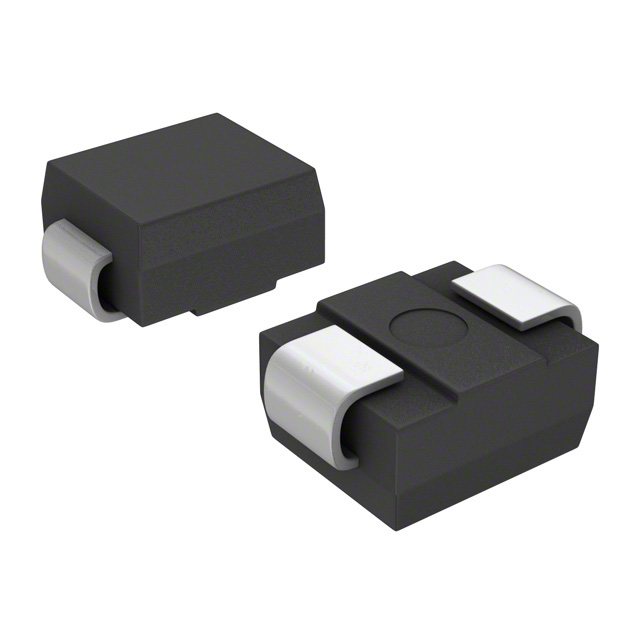SMBJ12-E3/5B
Product Overview
The SMBJ12-E3/5B belongs to the category of transient voltage suppressor diodes. These diodes are commonly used to protect sensitive electronic components from voltage spikes and transients. The SMBJ12-E3/5B is designed to provide robust protection for a wide range of applications, including telecommunications, industrial equipment, and consumer electronics. Its characteristics include high surge capability, low clamping voltage, and fast response time. The SMBJ12-E3/5B is typically available in a compact package and is offered in various packaging options, such as tape and reel or bulk packaging.
Specifications
- Part Number: SMBJ12-E3/5B
- Category: Transient Voltage Suppressor Diode
- Voltage Rating: 12V
- Peak Pulse Power: 600W
- Package Type: DO-214AA (SMB)
Detailed Pin Configuration
The SMBJ12-E3/5B follows the standard pin configuration for diodes in the DO-214AA package. It consists of two leads, with the anode connected to one lead and the cathode connected to the other lead.
Functional Features
The SMBJ12-E3/5B provides effective transient voltage suppression by diverting excessive current away from sensitive components when a voltage spike occurs. This helps to prevent damage to the connected circuitry and ensures the reliable operation of electronic devices.
Advantages and Disadvantages
Advantages: - High surge capability - Low clamping voltage - Fast response time
Disadvantages: - Limited to specific voltage ratings - May require additional circuitry for comprehensive protection in complex systems
Working Principles
When a voltage transient occurs, the SMBJ12-E3/5B enters a conductive state, allowing excess current to flow through it and bypass the protected components. This effectively limits the voltage across the components, safeguarding them from potential damage.
Detailed Application Field Plans
The SMBJ12-E3/5B is suitable for a wide range of applications, including: - Telecommunications equipment - Industrial control systems - Power supplies - Consumer electronics
Detailed and Complete Alternative Models
- SMBJ5.0A: 5.0V rating, 600W peak pulse power
- SMBJ24CA: 24V rating, 600W peak pulse power
- SMBJ48A: 48V rating, 600W peak pulse power
In conclusion, the SMBJ12-E3/5B transient voltage suppressor diode offers reliable protection against voltage transients and surges, making it an essential component in various electronic systems.
Word count: 398
Lista 10 Vanliga frågor och svar relaterade till tillämpningen av SMBJ12-E3/5B i tekniska lösningar
What is the SMBJ12-E3/5B?
- The SMBJ12-E3/5B is a surface mount transient voltage suppressor diode designed to protect sensitive electronic components from voltage spikes and transients.
What is the maximum peak pulse power of the SMBJ12-E3/5B?
- The maximum peak pulse power of the SMBJ12-E3/5B is 600 watts.
What is the breakdown voltage of the SMBJ12-E3/5B?
- The breakdown voltage of the SMBJ12-E3/5B is 12 volts.
What are the typical applications of the SMBJ12-E3/5B?
- The SMBJ12-E3/5B is commonly used in applications such as telecommunications equipment, industrial automation, and power supplies to protect against voltage transients.
What is the operating temperature range of the SMBJ12-E3/5B?
- The SMBJ12-E3/5B has an operating temperature range of -55°C to +150°C.
What is the response time of the SMBJ12-E3/5B?
- The response time of the SMBJ12-E3/5B is very fast, typically responding within nanoseconds to clamp transient voltages.
Does the SMBJ12-E3/5B require any external components for operation?
- No, the SMBJ12-E3/5B does not require any external components for its operation.
What is the package type of the SMBJ12-E3/5B?
- The SMBJ12-E3/5B comes in a surface mount DO-214AA (SMB) package.
Is the SMBJ12-E3/5B RoHS compliant?
- Yes, the SMBJ12-E3/5B is RoHS compliant, making it suitable for use in environmentally friendly electronic products.
Can the SMBJ12-E3/5B be used for overvoltage protection in automotive electronics?
- Yes, the SMBJ12-E3/5B can be used for overvoltage protection in automotive electronics, providing reliable protection against voltage surges and transients.


